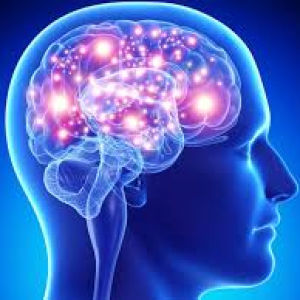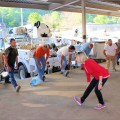
 Clients want to see results, and you want this, too. However, you’re with them a limited number of hours per week; you have little control over what they do when they’re not with you. What if you could provide additional tools that would help people reach their physical goals while also helping them make new neural connections?
Clients want to see results, and you want this, too. However, you’re with them a limited number of hours per week; you have little control over what they do when they’re not with you. What if you could provide additional tools that would help people reach their physical goals while also helping them make new neural connections?
Research suggests that prolonged sitting can be as bad for health as smoking (Owen, Bauman & Brown 2008; Owen et al. 2010). While consistent exercise and a healthy diet can help to counteract the effects of sitting too much, people still struggle to find a healthy center point. One avenue worth exploring is nonexercise activity thermogenesis (NEAT) (Levine 2003).
Total daily energy expenditure (TDEE) is the number of calories burned in a day, counting basal metabolic rate, the thermic effect of food, planned exercise and NEAT (Levine 2003). NEAT encompasses the calories burned while living life—walking to work, fidgeting, typing, chewing gum, folding clothes, washing dishes, running errands and so on; only sleeping, eating and sports are not included (Levine & Yeager 2009).
Increasing activity levels can be overwhelming for sedentary individuals, but fitness professionals can encourage clients to create mini habits, “little things” that act as stepping stones to an active lifestyle (Guise 2013). A study by McManus (2007) determined that burning approximately 150 calories a day with NEAT activities can prevent weight gain. This is a good starting point to increase movement, improve metabolism and enjoy better health.
Below are some NEAT brain boosters, simple activities clients can easily fit into their everyday lives to increase metabolism and improve brain health.
The Cognitive Key
The brain also benefits from movement. Simple activities can boost NEAT while building and strengthening the brain. Brain booster activities increase blood flow to the brain, feeding it with glucose and oxygen. When we move, our muscles produce proteins that travel through the bloodstream and into the brain to strengthen function (Ratey 2008).
Brain health is the result of a dynamic process in which a person engages in behaviors and environments that are beneficial to the brain. Brain health is also referred to as brain fitness, cognitive fitness and mental fitness (Nussbaum 2011). The brain’s neuroplasticity—its dynamic ability to constantly grow, change and reorganize throughout the lifespan—supports the need to stimulate the brain with healthy lifestyle choices.
The brain’s capacity for neurogenesis—generating new brain cells—provides an incentive to keep moving, learning, eating a healthy diet and connecting with others at all ages and stages of life.
NEAT Brain Boosters in Action
So what are NEAT brain booster activities? They are based on exercises that can
- strengthen the corpus callosum (band of neural fibers connecting the two hemispheres of the brain);
- boost levels of key neurotransmitters like dopamine, serotonin and norepinephrine;
- increase levels of neurotrophic factors like brain-derived-neurotrophic factor (BDNF), vascular-endothelial growth factor (VEGF) and insulin-like growth factor (IGF);
- improve mood;
- decrease levels of cortisol;
- raise a person’s stress threshold;
- help in effectively managing stress; and
- increase self-confidence.
(Eckmann 2013; Ratey 2008; Jensen 2000)
These short, simple activities increase metabolism while enhancing brain health through physical movement, mental stimulation, stress management and socialization. Teach these tools to clients and class participants as ways to improve health and wellness outcomes.
Yoga Brain Boosters
The following breath work is ideal for re-energizing the brain and body.
- Develop a 6-second breath cycle to get 10 breaths per minute. Inhale for 2 seconds, hold for 1 second, exhale for 2 seconds, hold for 1 second. Repeat.
- Practice alternate-nostril breathing. Gently close the opposite nostril, alternating thumb and ring fingers. Inhale through the right nostril; exhale through the left; inhale L; exhale R.
- Practice double breathing. Sit upright, palms on thighs. Inhale twice through the nose while tightening the muscles. Exhale through the nose and then the mouth, relaxing the muscles. Repeat several times.
On-the-Spot Brain Boosters
Remind clients how much NEAT adds up, and encourage them to try the following moves while standing in line at the post office or waiting for a colleague or family member.
- Flex from side to side while standing, with arms overhead to increase range of motion.
- Stretch the chest by clasping the hands behind the back and looking up. Inhale while stretching, and exhale on the release. Repeat several times.
- Perform squats and lunges.
- March while standing, feet close to the ground or with high knees.
- March while seated.
- Stand on one leg, shoulders stacked over hips, core engaged, knee lifted.
Seated Brain Boosters
Teach clients to do the following NEAT moves while sitting; they increase blood flow to the brain and engage the muscles to burn a few extra calories.
- Wiggle or tap the toes and fingers while watching television or sitting at a desk.
- Stand up and sit down at least every 10–20 minutes (every 5–10 minutes if possible); this boosts metabolism and strengthen the glutes and quads.
- Stand up and roll the shoulders up and back, one at a time and together.
- After keyboarding for 5–10 minutes, stop and make circles with both wrists. Open and close the fingers, making a “starfish.” Repeat.
- If you’ve been sitting awhile and you’re feeling sleepy or your back is tight, stand up and reach your hands to the opposite elbows behind your back. Look right and left.
- While sitting in a meeting with your legs beneath your desk, subtly lift one leg at a time. Do this several times; then, as you lift, point your toes to the ground and, as you lower, point the toes up.
- Fidget! The thing that drove your teachers nuts is one of the things that started research on the benefits of NEAT.
For more research and other NEAT activities, please see “Teach Clients This Smart Way to Move” in the online IDEA Library or in the September 2017 print edition of IDEA Fitness Journal. If you cannot access the full article and would like to, please contact the IDEA Inspired Service Team at 800-999-4332, ext. 7.
IDEA Fit Tips, Volume 16, Issue 1






